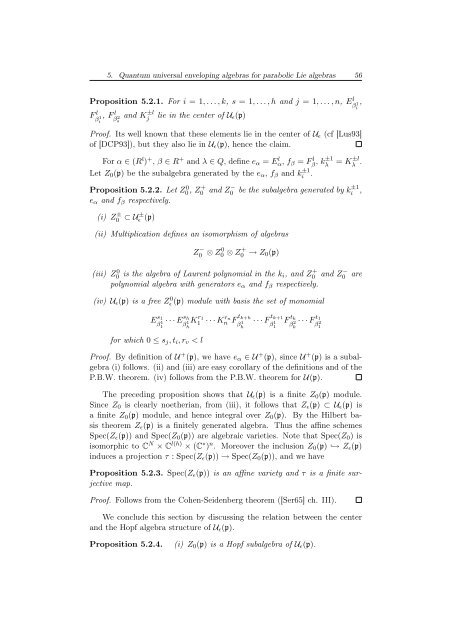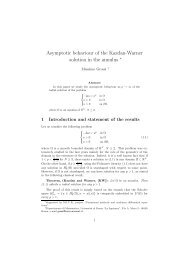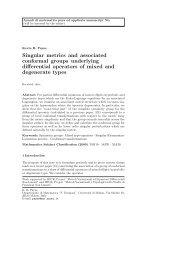Degree of Parabolic Quantum Groups - Dipartimento di Matematica ...
Degree of Parabolic Quantum Groups - Dipartimento di Matematica ...
Degree of Parabolic Quantum Groups - Dipartimento di Matematica ...
You also want an ePaper? Increase the reach of your titles
YUMPU automatically turns print PDFs into web optimized ePapers that Google loves.
5. <strong>Quantum</strong> universal enveloping algebras for parabolic Lie algebras 56<br />
Proposition 5.2.1. For i = 1, . . .,k, s = 1, . . .,h and j = 1, . . .,n, El β1, i<br />
F l<br />
β1, F<br />
i<br />
l β2 s<br />
and K±l<br />
j lie in the center <strong>of</strong> Uǫ(p)<br />
Pro<strong>of</strong>. Its well known that these elements lie in the center <strong>of</strong> Uǫ (cf [Lus93]<br />
<strong>of</strong> [DCP93]), but they also lie in Uǫ(p), hence the claim.<br />
For α ∈ (Rl ) + , β ∈ R + and λ ∈ Q, define eα = El α, fβ = F l β , k±1<br />
λ = K±l<br />
λ .<br />
Let Z0(p) be the subalgebra generated by the eα, fβ and k ±1<br />
i .<br />
Proposition 5.2.2. Let Z0 0 , Z+ 0 and Z− 0<br />
eα and fβ respectively.<br />
(i) Z ± 0 ⊂ U ± ǫ (p)<br />
(ii) Multiplication defines an isomorphism <strong>of</strong> algebras<br />
Z − 0 ⊗ Z0 0 ⊗ Z + 0<br />
be the subalgebra generated by k±1<br />
i ,<br />
→ Z0(p)<br />
(iii) Z 0 0 is the algebra <strong>of</strong> Laurent polynomial in the ki, and Z + 0 and Z− 0 are<br />
polynomial algebra with generators eα and fβ respectively.<br />
(iv) Uǫ(p) is a free Z 0 ǫ (p) module with basis the set <strong>of</strong> monomial<br />
E s1<br />
β 1 1<br />
for which 0 ≤ sj, ti, rv < l<br />
· · ·E sh<br />
β1K h<br />
r1<br />
1 · · ·Krn n F tk+h<br />
β1 h<br />
· · ·F tk+1<br />
β1 F<br />
1<br />
tk<br />
β2 · · ·F<br />
k<br />
t1<br />
β2 1<br />
Pro<strong>of</strong>. By definition <strong>of</strong> U + (p), we have eα ∈ U + (p), since U + (p) is a subalgebra<br />
(i) follows. (ii) and (iii) are easy corollary <strong>of</strong> the definitions and <strong>of</strong> the<br />
P.B.W. theorem. (iv) follows from the P.B.W. theorem for U(p).<br />
The prece<strong>di</strong>ng proposition shows that Uǫ(p) is a finite Z0(p) module.<br />
Since Z0 is clearly noetherian, from (iii), it follows that Zǫ(p) ⊂ Uǫ(p) is<br />
a finite Z0(p) module, and hence integral over Z0(p). By the Hilbert basis<br />
theorem Zǫ(p) is a finitely generated algebra. Thus the affine schemes<br />
Spec(Zǫ(p)) and Spec(Z0(p)) are algebraic varieties. Note that Spec(Z0) is<br />
isomorphic to C N × C l(h) × (C ∗ ) n . Moreover the inclusion Z0(p) ֒→ Zǫ(p)<br />
induces a projection τ : Spec(Zǫ(p)) → Spec(Z0(p)), and we have<br />
Proposition 5.2.3. Spec(Zǫ(p)) is an affine variety and τ is a finite surjective<br />
map.<br />
Pro<strong>of</strong>. Follows from the Cohen-Seidenberg theorem ([Ser65] ch. III).<br />
We conclude this section by <strong>di</strong>scussing the relation between the center<br />
and the Hopf algebra structure <strong>of</strong> Uǫ(p).<br />
Proposition 5.2.4. (i) Z0(p) is a Hopf subalgebra <strong>of</strong> Uǫ(p).








